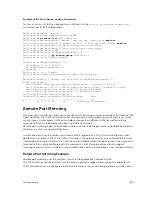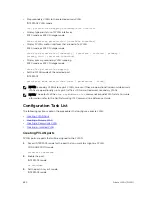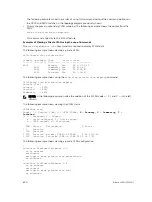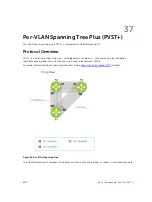
Configuring the Encapsulated Remote Port Mirroring
The ERPM session copies traffic from the source ports/lags or source VLANs and forwards the traffic
using routable GRE-encapsulated packets to the destination ip address specified in the session.
Important:
The steps to be followed for the ERPM Encapsulation :
• Dell Networking OS supports ERPM Source session only. The Encapsulated packets terminate at
the destination ip or at the analyzer.
• Make sure that the destination ip is reachable via the configured ip route (static or dynamic)
• The system MTU should be configured properly to accommodate the increased size of the
ERPM mirrored packet.
• The system encapsulates the complete ingress or egress data under GRE header, IP header and
outer MAC header and sends it out at the next hop interface as pointed by the routing table.
• The source IP address can be any port's ip address defined in the box but it should be unique
and should not be assigned to any other system in the network.
• The keyword ‘flow-based enable’ should have been specified in case of source as vlan or where
monitoring on a per flow basis is desired.
• The keyword monitor should have been specified in the access list rules for which we need to
mirror.
• The maximum number of source ports that can be defined in a session is 128.
• The system allows to configure upto 4 ERPM sessions.
• ERPM sessions do not copy locally sourced Remote-VLAN traffic from source trunk ports that
carry RPM VLANs. ERPM sessions do not copy locally sourced ERPM GRE-encapsulated traffic
from source ports.
• Source Vlan monitoring can be done only for ingress packets and is not supported for egress
direction.
Changes to Default Behavior
• Rate-limiting ïs no longer done for ERSPAN traffic.
• Same port can be configured as both source and destination in an ERSPAN session.
• TTL and ToS values can be configured in IP header of ERSPAN traffic.
Configuration steps for ERPM
ERPM sample steps for configuring the Source sessions
Step
Command
Purpose
1
configure terminal
Enter global configuration mode.
2
monitor session
<id>
type erpm
The <id> needs to be unique and not
already defined in the box specifying type
as 'erpm' defines a RPM session.
3
source
Interface | Range
Specify the port or list of ports that needs
to be monitored
628
Port Monitoring
Summary of Contents for Z9000
Page 1: ...Dell Configuration Guide for the Z9000 System 9 7 0 0 ...
Page 80: ...grub reboot 80 Management ...
Page 128: ... 0 Te 1 1 Te 1 2 rx Flow N A N A 128 Access Control Lists ACLs ...
Page 491: ...Figure 70 Configuring OSPF and BGP for MSDP Multicast Source Discovery Protocol MSDP 491 ...
Page 496: ...Figure 73 MSDP Default Peer Scenario 1 496 Multicast Source Discovery Protocol MSDP ...
Page 497: ...Figure 74 MSDP Default Peer Scenario 2 Multicast Source Discovery Protocol MSDP 497 ...
Page 498: ...Figure 75 MSDP Default Peer Scenario 3 498 Multicast Source Discovery Protocol MSDP ...
Page 760: ...Figure 100 Single and Double Tag TPID Match 760 Service Provider Bridging ...
Page 761: ...Figure 101 Single and Double Tag First byte TPID Match Service Provider Bridging 761 ...















































